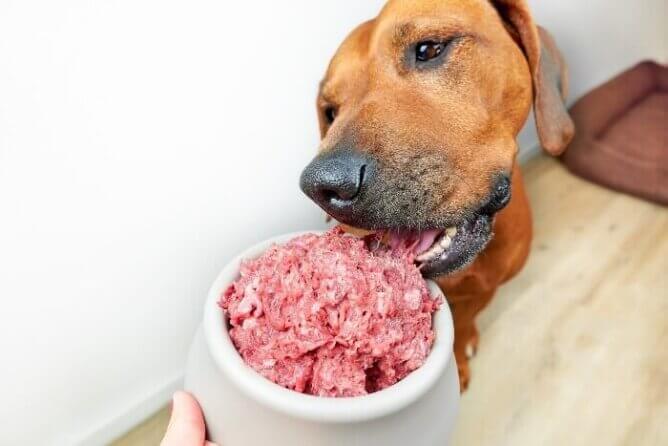Does High-Pressure Processing Make Raw Dog Food Safe?

DogFoodAdvisor is reader supported See how
Dog Food Advisor is 100% impartial and is never paid to promote any brand. But if you buy using links on this page, we may earn a referral fee.
One of the most valuable services we provide is our dog food recall alerts. If a dog food company recalls a product, we’ll let you know as soon as we can.
Some of the most alarming scares come when harmful bacteria such as salmonella are found in a batch of dog food. That alarm seems to increase disproportionately when raw dog food is involved, perhaps due to a lack of information or a surfeit of disinformation around that type of dog food and its production.
To worry is natural, of course. We all want our dogs to be safe. But the truth is that, with any type of dog food, there are good brands and not-so-good brands, especially when it comes to safety.
One method good raw food brands use to reduce the chance of contamination is high-pressure processing (HPP), also known as cold-pressure processing. But what is it and what does it do? Does it prevent contamination in raw food? Is it 100% effective?
We posed these and other questions to Amy Zalneraitis, Chief Brand Officer at 5-star-rated We Feed Raw. She, in turn, spoke to Mario González, PhD, HPP Food Applications Manager at high-pressure technology company Hiperbaric.
Here’s what Amy wrote…
Should dog parents worry about salmonella in raw food?
Most pet owners who hear this fact are surprised by it: while the number one cause of recalls in pet food as a whole is pathogenic bacteria, raw pet foods only make up 1.2% of this segment. Dry pet foods make up 98% of it. Based on these stats, kibble holds a greater risk for salmonella contamination than raw pet food does.
That’s said, it’s worth noting that there are safer raw pet foods than others. There are plenty of reputable raw companies in the U.S today, like We Feed Raw, who are offering a safe and balanced product. At We Feed Raw, our food is sourced from high-quality, USDA, human-grade meats. And we produce our recipes in a USDA-certified facility with strict safety regulations.
Most importantly, as part of our food safety program, we use HPP (high-pressure processing). HPP is a non-thermal processing technology that employs ultra-high water pressure (up to 87,000 psi) to inactivate food-borne pathogens such as Listeria, E. coli, and Salmonella. While not all raw companies in the U.S. use HPP, we incur the extra cost because it ensures a safe product.
What are the risks if salmonella or other harmful bacteria are present in dog food?
With their highly acidic stomachs and ultra-short digestive tracts, dogs are designed to handle bacteria in ways that humans cannot; salmonella is not typically an issue for healthy dogs (emphasis on the healthy), but it certainly can be for people, which is why we’re so committed to providing a safe, pathogen-free product.
This is especially relevant to pet parents feeding raw in homes that they share with small children, elderly family members, and immunocompromised people or dogs.
How is raw dog food kept safe?
At We Feed Raw, the ways we make our raw food safe are:
- Quality Sourcing: we use only high-quality USDA meats sourced from farms we trust in the USA and New Zealand.
- USDA-certified Facilities: All of our food is blended and packaged in a USDA-certified facility with strict BRC safe quality food requirements. (BRC is an internationally recognized benchmark for best practice in food safety, quality and responsibility.)
- Cold-pressure Processing: This is a process that doesn’t use heat, chemicals, or non-natural additives, but rather extreme cold-water pressure, to reduce/inactivate potentially harmful pathogens.
What is high-pressure processing?
High-pressure processing (HPP) is a non-thermal food processing technology applied to minimize the risk associated with foodborne pathogens. As explained by Mario González, PhD, HPP Food Applications Manager at Hiperbaric, “The technology uses cold water (4-25 °C; 40-75 °F) to generate pressure (up to 87 kpsi, equivalent to 6000 bar), which allows foods to retain chemical compounds providing nutrients.”
Not only is HPP used on raw pet foods, but it’s very commonly used on people foods as well: baby food, fish and meat products, cold-pressed juices, smoothies, cold-brew teas and coffee, plant-based milks, fresh cheese, raw milk, other dairy beverages, and the list goes on.
How does it make raw food safe?
HPP does a great job of keeping raw pet food safe without degrading nutrients. Our HPP step looks like this: BPA-free sealed packets are placed in a chamber with water and then pressurized (5 times more pressure than the ocean floor). Pathogenic bacteria can’t survive this extreme pressure. The packets are held under this pressure for around 3 minutes. They’re then moved to our freezer where they’re stored before being shipped frozen to customers’ doorsteps.
Is it 100% effective?
“There’s no such thing as a zero risk,” says Mario. “However, as long as the physicochemical characteristics of the pet food are adequate, the process does address the health risks to pets and humans associated with pathogens. In this regard, a high water content maximizes the lethal effect of HPP on pathogens.
“Raw meat and fresh vegetables have a water activity higher than 0.98, so they are very suited for the process. Scientific evidence supports this. For instance, a recent investigation led by the Institute for Food Safety and Health (IFSH) demonstrates that standard processing conditions (87k psi for 3 min) can well achieve a 5-log reduction of Salmonella on various beef, chicken and lamb pet food formulas.”
Is high-pressure processed raw food safer than kibble?
It’s less about what’s safer and more about what’s most nutritious and safe. With raw companies, they’re typically starting with much higher-quality ingredients than kibble manufacturers use. Raw diets are more bioavailable and species-appropriate than carb-heavy, highly processed kibble. And, ultimately, cold-pressured raw allows for a very safe pet food product.
Mario adds: “Different processes can achieve the same level of safety, but some processes are more gentle than others. Kibble is traditionally obtained through a process called extrusion, in which the ingredients are blended and then pushed through an extruder. If not cooked prior to blending, cooking takes place within the extruder as a consequence of friction forces inside the machine.
“Microorganisms are inactivated because of the high temperatures reached inside the extruder, but this over-processing has a negative impact on the quality and nutritional value of pet food. On the other hand, HPP is a nonthermal process that effectively inactivates microorganisms while avoiding the loss of quality associated with heat processing.”
What evidence is there to back any of this up?
“There are numerous independent scientific evidences supporting this,” says Mario. “For instance, García-Regueiro et al. (2007) demonstrated that processing beef at 87k psi for 10 min did not cause a significant reduction in the content of humidity, carbohydrates, proteins and amino acids.
“Likewise, no significant differences were observed in the content of vitamins B1, B2, B3, B6 and folic acid. More recently, Kim et al, 2021 reported that HPP did not cause detrimental effects on in-vitro protein digestibility of raw chicken meat. On the other hand, thermal processing between 140-194 °F reduced its digestibility.”
Also, as mentioned earlier, an investigation by the Institute for Food Safety and Health (IFSH) proved how effective this process can be. Together, these studies show the nutritional value stays consistent and the process of HPP is effective.
What are the downsides to high-pressure processing?
Aside from the misinformation about HPP, which can cause consumer confusion and doubt, we really only see upsides to this all-natural process. The FDA, which regulates pet food in the U.S., has a zero-tolerance policy for pathogenic bacteria in pet food, so in order to stay compliant, it’s vitally important for raw companies like us to be using a step like HPP.
Also, with so much fear-mongering around raw feeding, this gives pet parents extra peace of mind while feeding raw in the home. For We Feed Raw, this is huge because it allows us to get healthy, biologically appropriate food into more dogs’ bowls, which is at the heart of our mission.
Final word
The Dog Food Advisor does not accept money, gifts, samples or other incentives in exchange for special consideration in preparing our reviews.
However, we do receive a referral fee from online retailers (like Chewy or Amazon) and from sellers of perishable pet food when readers click over to their websites from ours. This helps cover the cost of operation of our free blog. Thanks for your support.
For more information, please visit our Disclaimer and Disclosure page.



